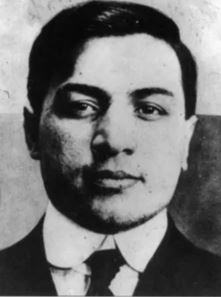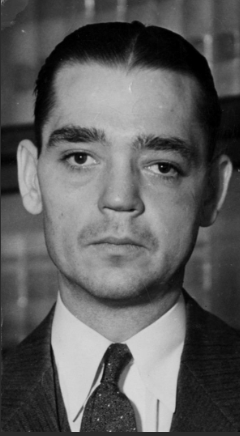In the cauldron of Prohibition-era crime, Gus Winkler was neither king nor myth — he was a shadow operative, someone entrusted with orchestrations, betrayals, and horrors few would acknowledge. He survived robbery, alliances, and betrayals. But in the end, his demise came not by an enemy’s blade foremost, but by the possibility that his lips might have parted.
This is the story of Winkler — his life, his crimes, his supposed confessions through others, and his death. And especially the question: was he killed because he knew too much?
From the Midwest to Mob’s Inner Workings
August Henry Winkeler (March 28, 1901 – October 9, 1933), known as Gus Winkler (or “Smiling Gus”), was born in Lemay, Missouri. He drifted into crime early: armed robbery, murder-for-hire, strong connections with Fred “Killer” Burke, and eventually into the orbit of Al Capone’s Chicago Outfit. He was one of the so-called “American Boys” — non-Italian henchmen and gunmen from St. Louis and elsewhere, used by Capone for dirty jobs that might require deniability.
Winkler married Georgette (née Bence) Winkeler. She survives in the record as someone invoked in later claims about what Winkler may have done, or at least what she believed or alleged.
The Yale Murder: Brooklyn, 1928 — Winkler’s Supposed Involvement
Frankie Yale, the Brooklyn mob boss whose operations and reputation filled papers and provoked rivals, was gunned down July 1, 1928. It was a killing widely believed to have involved Capone’s network. Yale had allowed Capone to operate in his territory, but disputes over hijacked liquor shipments, alliances, and growing power struggles made him a target.

Some historians and accounts link Winkler and Burke (and other “American Boys”) to Yale’s murder. The basis for this includes ballistic evidence (some of the same kinds of firearms), patterns of mobility of the shooters, and later claims from those who followed Winkler. One of the sources describing Winkler’s widow’s manuscript claims that she believed Winkler and his crew traveled to New York with Thompson submachine guns to participate in Yale’s murder.
As with so many gangster-era claims, there is no definitive court-level conviction or archival proof tying Winkler to Yale’s assassination. The story rests on the weight of later testimony, memoirs, and what Winkler’s widow alleged.
The St. Valentine’s Day Massacre: Widow’s Testimony and Confessions
Then there is February 14, 1929 — the day seven of Bugs Moran’s men (and associates) were lured to a Chicago garage and murdered in chillingly organized fashion. This massacre remains one of the most notorious crimes of 20th-century America. The murders were staged to look like a police raid; two men dressed as police, others in plain clothes, machine guns and shotguns used with cold precision.
The Widow’s Statement
Georgette Winkeler (Mrs. Gus Winkler) made statements, later kept in a manuscript she provided to the FBI, that Winkler may have participated. According to her, Winkler and his “American Boys,” including Fred Burke, Bob Carey, Raymond “Crane Neck” Nugent, and Fred Goetz, were involved in both the Yale murder and the Valentine’s Day Massacre. She claims that Winkler shared plans with her — sometimes in detail — including the use of Tommy guns, the method, the people.
Her testimony (or manuscript) is not universally accepted or verified to the standard of legal proof; historians debate its reliability. Some parts of her story align with confessions by other informants (for example, Byron Bolton) about who was present that morning of the massacre.
Confessions / Identifications
In 1935, Byron Bolton, a former gang associate, claimed to know who the shooters were: Fred Goetz, Gus Winkler, Fred Burke, Ray Nugent, and Bob Carey. He also said he (Bolton) had purchased the Cadillac used in the operation, with money from Capone’s network. These are the same names Georgette Winkeler later stated in her manuscript, which provides some corroboration among sources.
Bolton’s confession, however, is controversial because some of the individuals he named had alibis, or conflicting timelines. Some historians (for example Jonathan Eig) raise doubts about whether all of Bolton’s identifications could be correct.
The Murder of Winkler: Silence Bought with Blood?
October 9, 1933. Winkler, turning a doorknob at a beer depot in Chicago, is ambushed. Shotguns fire. He tries to stagger, reaches a hospital. He dies within the hour. He was 32.
The manner of his death seems almost ritualistic: quick, public, message-laden. Some believe this was more than just settling scores — that Winkler was silenced because his knowledge threatened powerful racketeers. Capone was in prison by then; Frank Nitti was consolidating power. If Winkler was speaking — to federal agents, to his wife, to others — about the Yale murder, the massacre, or other deeds, he was a liability.
The Unsettled Truth: What We Know, What We Don’t
- What we have strong reason to believe:
- That Gus Winkler was associated with Capone’s Outfit, especially as part of a subset known as the “American Boys,” used for special jobs.
- That his widow, Georgette, claimed in her manuscript (later given to the FBI) that Winkler was involved in both the Yale murder and the Valentine’s Day Massacre.
- That informants like Byron Bolton later made statements that aligned with her version of events.
- What is still unproven:
- Court conviction or forensic evidence that definitively places Winkler at the Yale murder.
- First-hand eyewitness testimony (other than Georgette’s later statements) that Winkler was one of the shooters in the Valentine’s Day Massacre.
- Whether his death was ordered specifically to prevent his talking about the massacre or Yale’s murder — it’s plausible, but no “smoking gun” proof (no internal paper trail, no public confession by the Outfit, etc.).
The Weight of Silence
Let’s imagine for a moment what Winkler might have known. If Georgette’s manuscript (which she gave to the FBI) is to be believed, he would have known the identities of shooters, the routes used, perhaps even the orders given. He would have known the weapons used — especially since some of the same guns (or at least of the same type) are claimed to have been used in both the Yale murder in New York and the St. Valentine’s Day hits in Chicago.
If any of that knowledge threatened to leak — if Mrs. Winkler’s manuscript or someone else’s testimony was credible — it could destabilize mob power, bring in law enforcement pressure, or expose alliances. And in the world of organized crime, such exposure is often managed with bullets, not subpoenas.
Epilogue: The Shadow of Gus Winkler
Gus Winkler’s life reads like a ledger of sins half confessed, of allegiances whose trails have been burned. He was young when he died — 32 — but already carrying the burdens of years in low-slung conspiracies and high-stakes bloodshed.
To some, his widow’s allegations are pieces of myth; to others, they are truth trapped in the cracks of newspapers, FBI files, and manuscripts shelved away. If he was involved in Yale’s murder, and in the Valentine’s Day Massacre, then his assassination may have been less about revenge than about silencing. He was too useful to throw away, until his usefulness became dangerous.
Whether Gus Winkler pulled the trigger, drove the car, ordered the hit, or simply knew too much to live — the darkness around his life seems less an accident than the design of the mob itself. Men like him are the ghosts behind the monsters. His true role — killer, planner, scapegoat, or all three — may never be known with full certainty. But his death, in public, shot with shotguns, remains a cautionary tale: in the underworld, knowledge is a weapon. And those with the weapons often live longer if they never speak.


